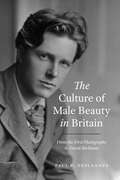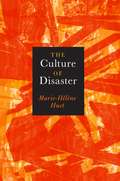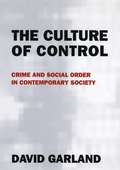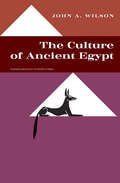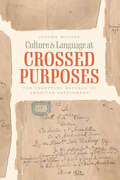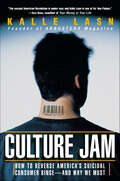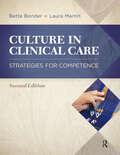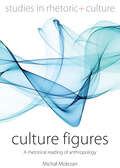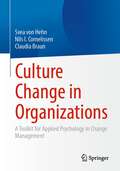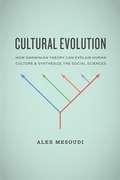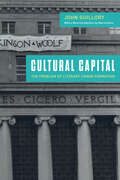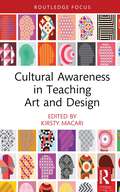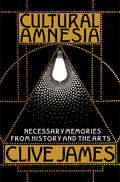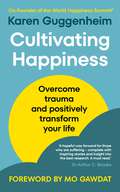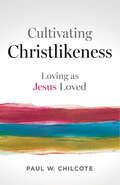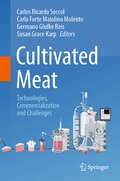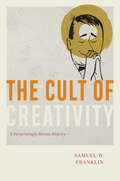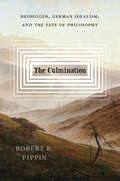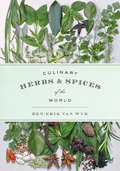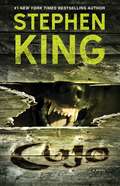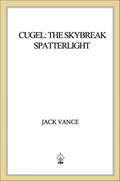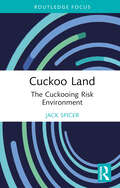- Table View
- List View
The Culture of Male Beauty in Britain: From the First Photographs to David Beckham
by Paul R. DeslandesA heavily illustrated history of two centuries of male beauty in British culture. Spanning the decades from the rise of photography to the age of the selfie, this book traces the complex visual and consumer cultures that shaped masculine beauty in Britain, examining the realms of advertising, health, pornography, psychology, sport, and celebrity culture. Paul R. Deslandes chronicles the shifting standards of male beauty in British culture—from the rising cult of the athlete to changing views on hairlessness—while connecting discussions of youth, fitness, and beauty to growing concerns about race, empire, and degeneracy. From earlier beauty show contestants and youth-obsessed artists, the book moves through the decades into considerations of disfigured soldiers, physique models, body-conscious gay men, and celebrities such as David Beckham and David Gandy who populate the worlds of television and social media. Deslandes calls on historians to take beauty and gendered aesthetics seriously while recasting how we think about the place of physical appearance in historical study, the intersection of different forms of high and popular culture, and what has been at stake for men in “looking good.”
The Culture of Disaster
by Marie-Hélène HuetFrom antiquity through the Enlightenment, disasters were attributed to the obscure power of the stars or the vengeance of angry gods. As philosophers sought to reassess the origins of natural disasters, they also made it clear that humans shared responsibility for the damages caused by a violent universe. This far-ranging book explores the way writers, thinkers, and artists have responded to the increasingly political concept of disaster from the Enlightenment until today. Marie-Hélène Huet argues that post-Enlightenment culture has been haunted by the sense of emergency that made natural catastrophes and human deeds both a collective crisis and a personal tragedy. From the plague of 1720 to the cholera of 1832, from shipwrecks to film dystopias, disasters raise questions about identity and memory, technology, control, and liability. In her analysis, Huet considers anew the mythical figures of Medusa and Apollo, theories of epidemics, earthquakes, political crises, and films such as Blow-Up and Blade Runner. With its scope and precision, The Culture of Disaster will appeal to a wide public interested in modern culture, philosophy, and intellectual history.
The Culture of Control: Crime and Social Order in Contemporary Society
by David GarlandThe past 30 years have seen vast changes in our attitudes toward crime. More and more of us live in gated communities; prison populations have skyrocketed; and issues such as racial profiling, community policing, and "zero-tolerance" policies dominate the headlines. How is it that our response to crime and our sense of criminal justice has come to be so dramatically reconfigured? David Garland charts the changes in crime and criminal justice in America and Britain over the past twenty-five years, showing how they have been shaped by two underlying social forces: the distinctive social organization of late modernity and the neoconservative politics that came to dominate the United States and the United Kingdom in the 1980s. Garland explains how the new policies of crime and punishment, welfare and security—and the changing class, race, and gender relations that underpin them—are linked to the fundamental problems of governing contemporary societies, as states, corporations, and private citizens grapple with a volatile economy and a culture that combines expanded personal freedom with relaxed social controls. It is the risky, unfixed character of modern life that underlies our accelerating concern with control and crime control in particular. It is not just crime that has changed; society has changed as well, and this transformation has reshaped criminological thought, public policy, and the cultural meaning of crime and criminals. David Garland's The Culture of Control offers a brilliant guide to this process and its still-reverberating consequences.
The Culture of Ancient Egypt: Originally published as The Burden of Egypt
by John A. WilsonThe story of Egypt is the story of history itself—the endless rise and fall, the life and death and life again of the eternal human effort to endure, enjoy, and understand the mystery of our universe. Emerging from the ancient mists of time, Egypt met the challenge of the mystery in a glorious evolution of religious, intellectual, and political institutions and for two millenniums flourished with all the vigor that the human heart can invest in a social and cultural order. Then Egypt began to crumble into the desert sands and the waters of the Nile, and her remarkable achievements in civilization became her lingering epitaph. John A. Wilson has written a rich and interpretive biography of one of the greatest cultural periods in human experience. He answers—as best the modern Egyptologist can—the questions inevitably asked concerning the dissolution of Egypt's glory. Here is scholarship in its finest form, concerned with the humanity that has preceded us, and finding in man's past grandeur and failure much meaning for men of today.
Culture & Language at Crossed Purposes: The Unsettled Records of American Settlement
by Jerome McGannCulture and Language at Crossed Purposes unpacks the interpretive problems of colonial treaty-making and uses them to illuminate canonical works from the period. Classic American literature, Jerome McGann argues, is haunted by the betrayal of seventeenth- and eighteenth-century Indian treaties—“a stunned memory preserved in the negative spaces of the treaty records.” A noted scholar of the “textual conditions” of literature, McGann investigates canonical works from the colonial period, including the Arbella sermon and key writings of William Bradford, John Winthrop, Anne Bradstreet, Cotton Mather’s Magnalia, Benjamin Franklin’s celebrated treaty folios and Autobiography, and Thomas Jefferson’s Notes on the State of Virginia. These are highly practical, purpose-driven works—the record of Enlightenment dreams put to the severe test of dangerous conditions. McGann suggests that the treaty-makers never doubted the unsettled character of what they were prosecuting, and a similar conflicted ethos pervades these works. Like the treaty records, they deliberately test themselves against stringent measures of truth and accomplishment and show a distinctive consciousness of their limits and failures. McGann’s book is ultimately a reminder of the public importance of truth and memory—the vocational commitments of humanist scholars and educators.
Culture Jam: How to Reverse America's Suicidal Consumer Binge—and Why We Must
by Kalle LasnAmerica is no longer a country but a multimillion-dollar brand, says Kalle Lasn and his fellow "culture jammers". The founder of Adbusters magazine, Lasn aims to stop the branding of America by changing the way information flows; the way institutions wield power; the way television stations are run; and the way the food, fashion, automobile, sports, music, and culture industries set agendas. With a courageous and compelling voice, Lasn deconstructs the advertising culture and our fixation on icons and brand names. And he shows how to organize resistance against the power trust that manages the brands by "uncooling" consumer items, by "dermarketing" fashions and celebrities, and by breaking the "media trance" of our TV-addicted age.A powerful manifesto by a leading media activist, Culture Jam lays the foundations for the most significant social movement of the early twenty-first century -- a movement that can change the world and the way we think and live.
Culture in Clinical Care: Strategies for Competence
by Laura Martin Bette BonderCulture in Clinical Care: Strategies for Competence explores theory and practice to define and describe the multidimensional nature of culture and its interaction with an individual’s experience in the development of beliefs, values, and behavior. The newly updated Second Edition examines cultural beliefs related to health and wellness and how these beliefs and their associated actions affect intervention strategies.Based on ethnographic methods, strategies for culturally sensitive assessment and intervention are defined and illustrated, with ample opportunities for reflection and practice. Going beyond traditional fact-centered and attitude-centered approaches, Culture in Clinical Care, Second Edition describes the ways in which culture emerges as individuals interact with each other in physical and social environments. This one-of-a-kind text by Dr. Bette Bonder and Dr. Laura Martin provides health care practitioners and students with chapter objectives, critical thinking questions, interdisciplinary case studies and examples, numerous activities to build observation and interaction skills, comprehensive references and online resources, and images. The book’s organization emphasizes practice and reflection by interweaving theory, examples, and continuous hands-on application of concepts. Readers have the opportunity to practice what they are learning and evaluate their own effectiveness while being constantly reminded that all individuals in any interaction embody numerous cultural influences.Benefits of the updated Second Edition:• Training and practice in ethnographic methods that build awareness and skill• Numerous examples, exercises, and activities for reflection and observation• Interdisciplinary approach suitable for cross-disciplinary teaching contexts• Definition of health care professions themselves as cultures• Web and bibliographic resources• Case studies involving a wide range of practitioner disciplines and cultural groupsCulture in Clinical Care: Strategies for Competence, Second Edition fills a niche in health professions programs because of its combined emphasis on a theoretical foundation that highlights the individual as a cultural actor and on practical strategies and methods for clinical interventions.Instructors in educational settings can visit www.efacultylounge.com for additional material to be used in the classroom, including a sample syllabus.Occupational therapists, physicians, physician assistants, mental health professionals, and a variety of related health professionals will benefit from this interactive, interdisciplinary text.
Culture Figures: A Rhetorical Reading of Anthropology (Studies in Rhetoric and Culture #10)
by Michał MokrzanEthnographic research, anthropological theory, and the understanding of the objects of inquiry, are co-created through figuration (using tropes and rhetorical figures) and techniques of persuasion. Delving into descriptive ethnography and theoretical texts spanning across classical monographs and recent texts in cultural anthropology, Culture Figures places rhetoric and rhetoricity as central to the discipline’s self-understanding. It focuses on how understandings of ‘culture’ and social life are shaped and conveyed in cultural anthropology through textual rhetoric. The book demonstrates how processes of using tropes and modes of persuasion underlie the creation of meanings or misunderstandings in society.
Culture Change in Organizations: A Toolkit for Applied Psychology in Change Management
by Svea von Hehn Nils I. Cornelissen Claudia BraunCulture change in four steps!This extraordinary and well-illustrated book offers you valuable insights and tools for the four iterative phases of cultural change. It serves as a reference and shows you how large-scale change happens through viral change.It offers valuable insights and combines important findings from applied psychology, case studies and practical instructions for action with valuable insights from behavioral economics and neuroscience. ContentsConcrete tools for the four iterative phases of cultural changePractical case studies from the corporate world, including digital change and New WorkIn-depth background knowledge on behavioral and mindset changeTips for culture change agents on how to use emotional intelligence and mindfulness to build resilience and master change in the face of resistanceHelpful didactics through illustrations, summaries, checklists of success factors, background,reflection and exercise boxesTarget groupsExecutives, human resources professionals, people from organizational development, consultants in startups, mid-sized companies and global international corporations as well as public organizationsAuthorsDr. Svea von Hehn has been working internationally as a management consultant (including for McKinsey & Company) since 1999. She holds a PhD in Psychology, is a multi-certified systemic coach and is a partner at RETURN ON MEANING.Nils I. Cornelissen has been working internationally as a management consultant (including for McKinsey & Company) since 2003. He holds a degree in Communications and a master's degree in Psychology and Sociology. He is a certified coach as well as a facilitator and partner at RETURN ON MEANING.Claudia Braun has been working internationally as a management consultant (including for McKinsey & Company) since 2007. She holds a degree inInternational Business Administration, a Master of Public Administration, a Master of Public Policy as well as various certifications. She is a partner at RETURN ON MEANING.The translation was done with the help of artificial intelligence. A subsequent human revision was done primarily in terms of content.
Cultural Evolution: How Darwinian Theory Can Explain Human Culture & Synthesize the Social Sciences
by Alex MesoudiCharles Darwin changed the course of scientific thinking by showing how evolution accounts for the stunning diversity and biological complexity of life on earth. Recently, there has also been increased interest in the social sciences in how Darwinian theory can explain human culture. Covering a wide range of topics, including fads, public policy, the spread of religion, and herd behavior in markets, Alex Mesoudi shows that human culture is itself an evolutionary process that exhibits the key Darwinian mechanisms of variation, competition, and inheritance. This cross-disciplinary volume focuses on the ways cultural phenomena can be studied scientifically—from theoretical modeling to lab experiments, archaeological fieldwork to ethnographic studies—and shows how apparently disparate methods can complement one another to the mutual benefit of the various social science disciplines. Along the way, the book reveals how new insights arise from looking at culture from an evolutionary angle. Cultural Evolution provides a thought-provoking argument that Darwinian evolutionary theory can both unify different branches of inquiry and enhance understanding of human behavior.
Cultural Capital: The Problem of Literary Canon Formation
by John GuilloryAn enlarged edition to celebrate the thirtieth anniversary of John Guillory’s formative text on the literary canon. Since its publication in 1993, John Guillory’s Cultural Capital has been a signal text for understanding the codification and uses of the literary canon. Cultural Capital reconsiders the social basis for aesthetic judgment and exposes the unequal distribution of symbolic and linguistic knowledge on which culture has long been based. Drawing from Pierre Bourdieu’s sociology, Guillory argues that canon formation must be understood less as a question of the representation of social groups and more as a question of the distribution of cultural capital in schools, which regulate access to literacy, to the practices of reading and writing. Now, as the crisis of the canon has evolved into the so-called crisis of the humanities, Guillory’s groundbreaking, incisive work has never been more urgent. As scholar and critic Merve Emre writes in her introduction to this enlarged edition: “Exclusion, selection, reflection, representation—these are the terms on which the canon wars of the last century were fought, and the terms that continue to inform debates about, for instance, decolonizing the curriculum and the rhetoric of antiracist pedagogy.”
Cultural Burning (Elements in Current Archaeological Tools and Techniques)
by null Bruno David null Jean-Jacques Delannoy null Jessie Birkett-Rees null Michael-Shawn Fletcher null Simon Connor null Virginia Ruth Pullin null Michela Mariani null Anthony Romano null S. Yoshi MaezumiThis Element addresses a burning question – how can archaeologists best identify and interpret cultural burning, the controlled use of fire by people to shape and curate their physical and social landscapes? This Element describes what cultural burning is and presents current methods by which it can be identified in historical and archaeological records, applying internationally relevant methods to Australian landscapes. It clarifies how the transdisciplinary study of cultural burning by Quaternary scientists, historians, archaeologists and Indigenous community members is informing interpretations of cultural practices, ecological change, land use and the making of place. This title is also available as Open Access on Cambridge Core.
Cultural Awareness in Teaching Art and Design (Routledge Focus on Design Pedagogy)
by Kirsty MacariCultural Awareness in Teaching Art and Design addresses an emerging area of development in contemporary pedagogy, the fostering of cultural awareness and sensitivity in the designers of tomorrow.By offering new and unique examples of how to better educate students around issues of cultural awareness, this book presents teaching methodologies that ultimately facilitate students in becoming better, and more inclusive, art and design professionals. Today, the role of education in the addressing of social and cultural issues is increasingly seen as central to pedagogical methodologies. Through engaged teaching, experiential learning, socially orientated pedagogy or any other definition, the idea that students can and should be exposed to, and deal with, issues of importance to various stakeholders is increasingly seen as central to the teaching and learning experience – whether it be in relation to local communities, national economies, regional cultural identities or more. This is explored in a series of innovative, cross-disciplinary case studies in art and design teaching, with authors approaching questions of cultural awareness and engagement through the lenses of art history, product design, communication design, film, architecture and interior design. In presenting their pedagogical methodologies and case studies, the authors in this text offer a unique cross-disciplinary design perspective that captures the cultural and social concerns of several regions of the world: Europe, North America, Asia and Africa and the Middle East.This book will be essential reading for art and design educators and students interested in developing and applying models of cultural awareness and engagement in the classroom and studio.
Cultural Amnesia: Necessary Memories From History And The Arts
by Clive James"I can't remember when I've learned as much from something I've read—or laughed as much while doing it." —Jacob Weisberg, Slate This international bestseller is an encyclopedic A-Z masterpiece—the perfect introduction to the very core of Western humanism. Clive James rescues, or occasionally destroys, the careers of many of the greatest thinkers, humanists, musicians, artists, and philosophers of the twentieth century. Soaring to Montaigne-like heights, Cultural Amnesia is precisely the book to burnish these memories of a Western civilization that James fears is nearly lost.
Cultivating Livability: Food, Class, and the Urban Future in Bengaluru
by Camille FrazierWhat urban food networks reveal about middle class livability in times of transformation In recent years, the concept of &“livability&” has captured the global imagination, influencing discussions about the implications of climate change on human life and inspiring rankings of &“most livable cities&” in popular publications. But what really makes for a livable life, and for whom? Cultivating Livability takes Bengaluru, India, as a case study—a city that is alternately described as India&’s most and least livable megacity, where rapid transformation is undergirded by inequalities evident in the food networks connecting peri-urban farmers and the middle-class public. Anthropologist Camille Frazier probes the meaning of &“livability&” in Bengaluru through ethnographic work among producers and consumers, corporate intermediaries and urban information technology professionals. Examining the varying efforts to reconfigure processes of food production, distribution, retail, and consumption, she reveals how these intersections are often rooted in and exacerbate ongoing forms of disenfranchisement that privilege some lives at the expense of others.
Cultivating Happiness: Overcome trauma and positively transform your life
by Karen GuggenheimIs it possible to overcome pain by learning to be happy?This is the question Karen Guggenheim asked herself after the sudden death of her husband in 2013. Overwhelmed by this unexpected loss, Karen decided to use her grief as a motivator to look inwards and embark on a transformative journey of post-traumatic growth, which led her to become the co-founder of the World Happiness Summit, the leading happiness conference in the world.Drawing from her personal experiences and research in psychology and neuroscience, Karen reveals that happiness can be taught and learned, and that, through small daily changes, we can all bring more compassion and positivity into our days to feel better about ourselves and others.Cultivating Happiness is a practical and accessible guide to dealing with adversity, showing us that it is possible to grow from our challenges and lead more fulfilling and purposeful lives.
Cultivating Christlikeness: Loving as Jesus Loved
by Paul W. ChilcoteAre you ready to reclaim our inheritance as United Methodist Wesleyans?Our communities and the world are crying out for empathy, authenticity, and integrity. This book helps us choose ways of living that are grace-filled and redeeming. Cultivating Christlikeness is about the bold adventure of United Methodists celebrating and living into a grand vision that includes everyone in God’s extravagant embrace. Jesus invites us to partner in the work of transformation, new birth, and resurrection in every aspect of our lives. Together we can step into a future showered by God’s multiplying love.Paul Chilcote mines his decades of study, prayer, and devotion to Christian practices to share his vision for how we partner with God to make the world more loving and just. In Cultivating Christlikeness, he weaves the threads of insight and appreciation with special attention to Wesleyan ways of loving God and neighbor that can change us and change the world. With his gentle direction, we discover with new appreciation how 18th-century John and Charles Wesley illumine our 21st-century quest to befriend Jesus, who frees us to live into and by the grace of God.Chilcote’s book is a practical guide. He guides us with a mentor’s insightful nudge as we explore essential Wesleyan teachings about God and the beloved community. He helps us know how to share these understandings with our families and neighbors, and more importantly, he points us to ways to live out our commitments with purpose, courage, and joy.The framework and flow of Cultivating Christlikeness make it easily adaptable for group discussion and individual use. It includes a plan for a two-day retreat for those eager to join in a more intensive experience of mutual engagement to renew their spirits and discover fresh ways to grow in love and grace. The book is a companion to Chilcote’s, Multiplying Love (Abingdon Press), which casts the theological vision that animates this practical spiritual guide. And it is an updated and expanded revision of an earlier work entitled, Wesley Speaks on Christian Vocation, originally published by Discipleship Ministries, then reissued by Wipf & Stock.
Cultivated Meat: Technologies, Commercialization and Challenges
by Carlos Ricardo Soccol Carla Forte Maiolino Molento Germano Glufke Reis Susan Grace KarpCultivated meat is an emerging substitute for conventional meat that is not associated with animal farming and slaughtering. Instead, animal cells are cultivated in bioreactors and post-processed into “artificial” meat products. Although this new technology solves several ethical and environmental problems, there are techno-economic challenges that need to be addressed to make the commercial-scale production of cultivated meat a real perspective. This book addresses fundamental aspects of new food systems, animal cell culture and cultivated meat production, including cell lines, culture media, microcarriers and scaffolds, bioreactors, downstream processes, formulation, packaging, quality control, scale-up, and waste management. Also, aspects related to commercialization, market, patents, legislation, global and regional policies, and sustainability metrics such as life-cycle assessment, together with a bioeconomy perspective analysis, are reviewed. Finally, case studies are presented and the challenges and future prospects for cultivated meat production are proposed. This book is a collection of 21 chapters written by specialists in the field.
The Cult of Creativity: A Surprisingly Recent History
by Samuel W. FranklinA history of how, in the mid-twentieth century, we came to believe in the concept of creativity. Named a best book of 2023 by the New Yorker and a notable book of 2023 by Behavioral Scientist. Creativity is one of American society’s signature values, but the idea that there is such a thing as “creativity”—and that it can be cultivated—is surprisingly recent, entering our everyday speech in the 1950s. As Samuel W. Franklin reveals, postwar Americans created creativity, through campaigns to define and harness the power of the individual to meet the demands of American capitalism and life under the Cold War. Creativity was championed by a cluster of professionals—psychologists, engineers, and advertising people—as a cure for the conformity and alienation they feared was stifling American ingenuity. It was touted as a force of individualism and the human spirit, a new middle-class aspiration that suited the needs of corporate America and the spirit of anticommunism. Amid increasingly rigid systems, creativity took on an air of romance; it was a more democratic quality than genius, but more rarified than mere intelligence. The term eluded clear definition, allowing all sorts of people and institutions to claim it as a solution to their problems, from corporate dullness to urban decline. Today, when creativity is constantly sought after, quantified, and maximized, Franklin’s eye-opening history of the concept helps us to see what it really is, and whom it really serves.
The Culmination: Heidegger, German Idealism, and the Fate of Philosophy
by Robert B. PippinA provocative reassessment of Heidegger’s critique of German Idealism from one of the tradition’s foremost interpreters. Heidegger claimed that Western philosophy ended—failed, even—in the German Idealist tradition. In The Culmination, Robert B. Pippin explores the ramifications of this charge through a masterful survey of Western philosophy, especially Heidegger’s critiques of Hegel and Kant. Pippin argues that Heidegger’s basic concern was to determine sources of meaning for human life, particularly those that had been obscured by Western philosophy’s attention to reason. The Culmination offers a new interpretation of Heidegger, German Idealism, and the fate of Western rationalism.
Culinary Herbs & Spices of the World
by Ben-Erik van WykFor centuries herbs and spices have been an integral part of many of the world’s great cuisines. But spices have a history of doing much more than adding life to bland foods. They have been the inspiration for, among other things, trade, exploration, and poetry. Priests employed them in worship, incantations, and rituals, and shamans used them as charms to ward off evil spirits. Nations fought over access to and monopoly of certain spices, like cinnamon and nutmeg, when they were rare commodities. Not only were many men’s fortunes made in the pursuit of spices, spices at many periods throughout history literally served as currency. In Culinary Herbs and Spices of the World, Ben-Erik van Wyk offers the first fully illustrated, scientific guide to nearly all commercial herbs and spices in existence. Van Wyk covers more than 150 species—from black pepper and blackcurrant to white mustard and white ginger—detailing the propagation, cultivation, and culinary uses of each. Introductory chapters capture the essence of culinary traditions, traditional herb and spice mixtures, preservation, presentation, and the chemistry of flavors, and individual entries include the chemical compounds and structures responsible for each spice or herb’s characteristic flavor. Many of the herbs and spices van Wyk covers are familiar fixtures in our own spice racks, but a few—especially those from Africa and China—will be introduced for the first time to American audiences. Van Wyk also offers a global view of the most famous use or signature dish for each herb or spice, satisfying the gourmand’s curiosity for more information about new dishes from little-known culinary traditions. People all over the world are becoming more sophisticated and demanding about what they eat and how it is prepared. Culinary Herbs and Spices of the World will appeal to those inquisitive foodies in addition to gardeners and botanists.
Cujo: A Novel (Collections Litterature Ser. #Vol. 6001333)
by Stephen KingThe #1 New York Times bestseller, Cujo &“hits the jugular&” (The New York Times) with the story of a friendly Saint Bernard that is bitten by a bat. Get ready to meet the most hideous menace ever to terrorize the town of Castle Rock, Maine.Outside a peaceful town in central Maine, a monster is waiting. Cujo is a two-hundred-pound Saint Bernard, the best friend Brett Camber has ever had. One day, Cujo chases a rabbit into a cave inhabited by sick bats and emerges as something new altogether. Meanwhile, Vic and Donna Trenton, and their young son Tad, move to Maine. They are seeking peace and quiet, but life in this small town is not what it seems. As Tad tries to fend off the terror that comes to him at night from his bedroom closet, and as Vic and Donna face their own nightmare of a marriage on the rocks, there is no way they can know that a monster, infinitely sinister, waits in the daylight. What happens to Cujo, how he becomes a horrifying vortex inescapably drawing in all the people around him, makes for one of the most heart-stopping novels Stephen King has ever written. &“A genuine page-turner that grabs you and holds you and won&’t let go&” (Chattanooga Times), Cujo will forever change how you view man&’s best friend.
Cugel: The Skybreak Spatterlight (Mazirian The Magician Ser.)
by Jack VanceJack Vance is one of the most remarkable talents to ever grace the world of science fiction. His unique, stylish voice has been beloved by generations of readers. One of his enduring classics is his Mazirian the Magician (previously titled The Dying Earth), and its sequels--a fascinating, baroque tale set on a far-future Earth, under a giant red sun that is soon to go out forever.In Cugel: the Skybreak Spatterlight , Cugel the Clever is still seeking revenge on the magician Iucounu, whom he blames for his exile and all his troubles. But revenge is hard to come by, and the adventures on the way are so very diverting….At the Publisher's request, this title is being sold without Digital Rights Management Software (DRM) applied.
Cuckoo Land: The Cuckooing Risk Environment (Drugs, Crime and Society)
by Jack SpicerDrawing on rich qualitative data, this book presents a novel way of understanding the drug market-related harm of ‘cuckooing’, providing a theoretically informed account of this increasingly high-profile area.Applying the framework of the ‘risk environment’, the book examines why people become cuckooed, how it is responded to and how this exploitative practice is socially produced. In doing so, a diverse range of environments and features relevant to cuckooing are analysed, including the role of housing, political economy, drug policy, policing and social exclusion. By interrogating how these constrain and enable the actions of people who are affected, the book develops a critical analysis that recognises the complexity of cuckooing while eschewing superficial explanations of why it occurs. Resisting simplistic solutions, it also considers what an enabling environment capable of reducing the harms of this exploitative practice might look like.Cuckoo Land will be of interest to academic researchers in the fields of criminology, victimology, social work and drugs. It will also be essential reading for policymakers and practitioners working on the issue of cuckooing.
Cubicle Warfare: 101 Office Traps and Pranks
by John AustinA guide to the best ways to lighten the mood at the office, from fun pranks to strategies for getting revenge on annoying coworkersPerfect for every cubicle drone whose eyes are beginning to glaze over from fluorescent lighting and too many burned cups of coffee, Cubicle Warfare is a guide to having fun during the daily grind. Readers will learn how to make their coworkers jump, squeal, and run for cover with hilarious office traps such as the Paper Clip Chain and the Post-it Fake Out, as well as the more advanced Freezer Bomb, Foil Office, 5 Blind Mice, and Keyboard Clover. Even if readers are not pranksters themselves, they can still use Cubicle Warfare to recognize warning signs and defend their cubicles from conniving coworkers. With Cubicle Warfare, dissatisfied office workers can vent their frustrations in fun and harmless ways—and then get back to work.
